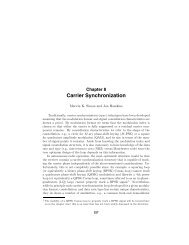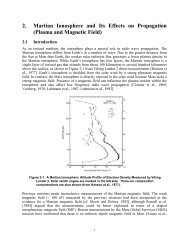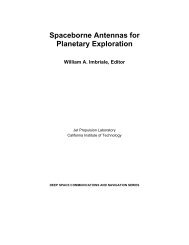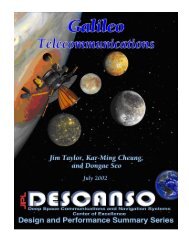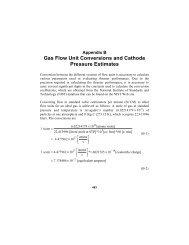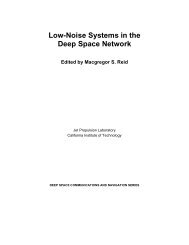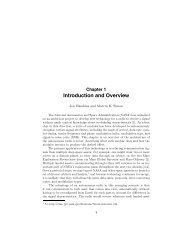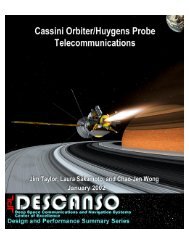Propagation Effects Handbook for Satellite Systems - DESCANSO ...
Propagation Effects Handbook for Satellite Systems - DESCANSO ...
Propagation Effects Handbook for Satellite Systems - DESCANSO ...
Create successful ePaper yourself
Turn your PDF publications into a flip-book with our unique Google optimized e-Paper software.
B<br />
. .<br />
Figure 6.5-2 represents the average Sz as derived from the<br />
O.S.U. empirical constants. However, since both 021, and OZZ may be<br />
represented in closed <strong>for</strong>m as a function of Czn (Tatarski-1961),<br />
instantaneous~ diurnal~ or seasonal values <strong>for</strong> Sz may be found from<br />
this model given an estimate of the appropriate Czn.<br />
6.5.2.2.1 Applicability of the Model. The empirical constants<br />
which were found from observed data are applicable <strong>for</strong> the<br />
prediction of average turbulence-induced propagation effects in a<br />
temperate climate, during the warmer seasons of the year, and under<br />
non-precipitating clear-air conditions. It is necessary to derive<br />
local estimates of Czn <strong>for</strong> the model if these conditions are not the<br />
same.<br />
6.5.2.2.2 Distribution of Amplitude Variance. It is known that<br />
peak-to-peak variations of 30 N-units in the refractive index are<br />
expected on a time scale of days and hours (Theobold-1978).<br />
Corresponding fluctuations in received signal amplitude variance<br />
expressed in dB would be expected to be about 20 dB peak-to-peak <strong>for</strong><br />
a fluctuation of 30 N-units out of an average of 345. Figure 6.5-3<br />
shows a representative case of average amplitude variance at 30 GHz<br />
<strong>for</strong> a 4.6 m diameter aperture as a function of elevation angle.<br />
Curves <strong>for</strong> plus or minus 10 dB variation in C2n about the average are<br />
shown <strong>for</strong> comparison.<br />
A more exact representation of the expected distribution of<br />
amplitude variance may be obtained given measured statistics of<br />
variance variability about the average. Figures 6.5-4a and b<br />
present probability distribution functions of variance differences<br />
<strong>for</strong> 2 and 30 GHz earth-space signals measured over a period of 26<br />
days. The satellite was undergoing transition in elevation from<br />
0.38° to 45° and the mean variance was removed as a function of<br />
elevation angle. The 90% confidence limits of 14.6 and 14.7 dB,<br />
respectively, are in good agreement with the statistics of expected<br />
refractive index variation.<br />
6-79





